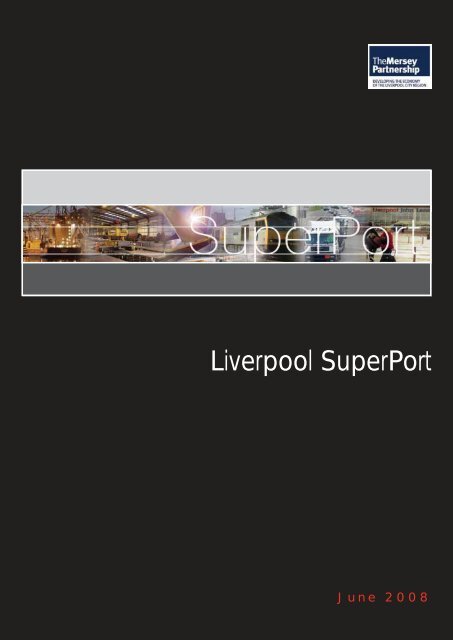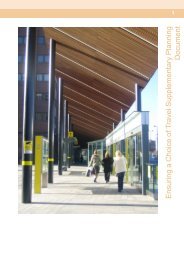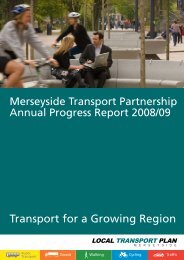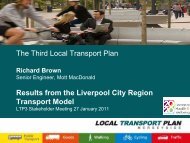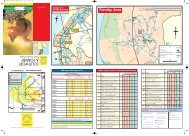Liverpool SuperPort - the TravelWise Merseyside website
Liverpool SuperPort - the TravelWise Merseyside website
Liverpool SuperPort - the TravelWise Merseyside website
Create successful ePaper yourself
Turn your PDF publications into a flip-book with our unique Google optimized e-Paper software.
<strong>Liverpool</strong> <strong>SuperPort</strong><br />
June 2008
<strong>SuperPort</strong><br />
<strong>Liverpool</strong> <strong>SuperPort</strong> integrates air, port, logistics and transportation<br />
2 | <strong>SuperPort</strong>
<strong>SuperPort</strong><br />
FOREWORD<br />
from Lorraine Rogers,<br />
Chief Executive of<br />
The Mersey Partnership<br />
<strong>Liverpool</strong>'s position as a vibrant and worldrenowned<br />
port is still within living memory. It<br />
is encouraging, <strong>the</strong>refore, that as we take on<br />
<strong>the</strong> role of European Capital of Culture, and<br />
start to realise <strong>the</strong> physical transformation of<br />
<strong>the</strong> <strong>Liverpool</strong> City Region, we are now<br />
reassessing its position as a major<br />
international gateway.<br />
Locations such as Singapore, Dubai and<br />
Malaysia have flourished as international<br />
gateways through innovative thinking, high<br />
levels of private sector investment and<br />
integrating core assets such as airports,<br />
logistics operations and ports effectively.<br />
They have grasped a share of globally<br />
competitive markets and driven forward <strong>the</strong>ir<br />
local economies accordingly. <strong>Liverpool</strong> City<br />
Region's vision is to regain our place back<br />
among this elite group and our response is<br />
<strong>Liverpool</strong> <strong>SuperPort</strong>.<br />
As Chief Executive of The Mersey<br />
Partnership, <strong>the</strong> body responsible for<br />
economic development and inward<br />
investment across <strong>the</strong> <strong>Liverpool</strong> City Region,<br />
I am pleased to be able to write <strong>the</strong> foreword<br />
to this prospectus that opens up <strong>the</strong><br />
<strong>SuperPort</strong> concept. It outlines <strong>the</strong> capabilities<br />
we currently possess and highlights <strong>the</strong><br />
challenges we face in delivering our vision.<br />
The task ahead of us is formidable, but<br />
through developing effective partnerships<br />
and working toge<strong>the</strong>r as a united force for<br />
<strong>the</strong> <strong>Liverpool</strong> City Region <strong>the</strong> vision is well<br />
within our reach.<br />
I would <strong>the</strong>refore encourage you to read this<br />
prospectus and let us know your opinions on<br />
how <strong>SuperPort</strong> will drive forward your own,<br />
and <strong>the</strong> City Region’s, strategic thinking.<br />
<strong>SuperPort</strong> | 3
<strong>SuperPort</strong><br />
The Port of <strong>Liverpool</strong>:<br />
Maritime Powerhouse<br />
For <strong>the</strong> last 300 years <strong>the</strong> <strong>Liverpool</strong> City Region has<br />
developed as a strategically and geographically<br />
important port, key to <strong>the</strong> UK economy. In 1715 <strong>the</strong><br />
first dock was built on <strong>the</strong> Mersey, but such was <strong>the</strong><br />
demand that four more docks had to be constructed<br />
during <strong>the</strong> course of <strong>the</strong> century. Now covering more<br />
than 200 acres <strong>Liverpool</strong> became Britain's 3rd largest<br />
port driven by <strong>the</strong> emergence of new industries across<br />
Lancashire such as coal, textiles, soap and glassmaking.<br />
However as <strong>the</strong> 20th century progressed, <strong>the</strong> lack of a<br />
manufacturing base began to have a negative effect,<br />
and <strong>the</strong> Port, once <strong>the</strong> lifeblood of <strong>the</strong> City, began to<br />
decline. This was compounded in <strong>the</strong> late 1960s and<br />
<strong>the</strong> 1970s by <strong>the</strong> restructuring of <strong>the</strong> UK economy.<br />
Despite <strong>the</strong> contraction of port activities many of <strong>the</strong><br />
capabilities that were developed during <strong>the</strong> intense<br />
growth period remained. <strong>Liverpool</strong> continued to have a<br />
depth in maritime and logistical skills and still held<br />
control over major world markets such as cotton<br />
trading.<br />
Today, it's a case of 'back to <strong>the</strong> future' for <strong>the</strong> Port as it<br />
begins to re-establish itself in increasingly globalised<br />
markets. This is reflected not only in <strong>the</strong> growth of <strong>the</strong><br />
Mersey ports, which are setting freight volume records,<br />
ACL ship at Seaforth Container Terminal<br />
but also by powerful new players such as <strong>Liverpool</strong><br />
John Lennon Airport, one of <strong>the</strong> UK's fastest growing<br />
airports, handling 5.5 million passengers in 2007, and<br />
large-scale logistics operators such as <strong>the</strong> Stobart<br />
Group and those developing infrastructure at Parkside<br />
(St.Helens) and Omega (Warrington).<br />
Driving growth is a substantial local economy<br />
estimated by <strong>the</strong> North West Regional Development<br />
Agency to be a £98 billion economy with 6.8 million<br />
people and 230,000 firms across <strong>the</strong> North West.<br />
Fundamentally, <strong>Liverpool</strong> remains a great place for<br />
doing <strong>the</strong> things that supported its early growth,<br />
notably handling <strong>the</strong> UK’s trade with <strong>the</strong> USA (<strong>the</strong><br />
worlds largest economy) and maintaining links with<br />
Ireland and key emerging markets in <strong>the</strong> Far East.<br />
Seaforth Container Terminal<br />
4 | <strong>SuperPort</strong>
<strong>SuperPort</strong><br />
A New Resurgence<br />
The <strong>Liverpool</strong> City Region, encompassing <strong>the</strong> six<br />
boroughs of <strong>Liverpool</strong>, Sefton, Wirral, St Helens,<br />
Knowsley and Halton joined by <strong>the</strong> wider area that sits<br />
within <strong>the</strong> economic influence of <strong>the</strong> City, is resurgent<br />
and growing in confidence.<br />
The conditions giving rise to this growth have been<br />
created by a number of global events and trends, and,<br />
in <strong>the</strong> case of <strong>the</strong> Mersey Ports growth has been<br />
stimulated in response to port congestion elsewhere in<br />
<strong>the</strong> UK, most notably in <strong>the</strong> South. This has resulted in<br />
a pipeline for new projects, and supporting<br />
infrastructure in <strong>Liverpool</strong>, that is arguably at an<br />
unprecedented level for modern times.<br />
<strong>Liverpool</strong> City Region has recently made considerable<br />
strides through harnessing local support. The public<br />
sector has worked toge<strong>the</strong>r and developed effective<br />
partnerships that have kept <strong>the</strong>ir focus on <strong>the</strong> big<br />
picture, whilst at <strong>the</strong> same time private sector leaders<br />
have engaged in enlightened support of industry as a<br />
whole, over and above <strong>the</strong> interest of individual<br />
companies. In addition, corporate events have resulted<br />
<strong>Liverpool</strong> John Lennon Airport<br />
Proposed Post-Panamax Terminal<br />
in <strong>the</strong> common ownership of much of <strong>the</strong> City’s major<br />
port and airport infrastructure, with o<strong>the</strong>r major<br />
companies involved in logistics, air passenger services<br />
and transport infrastructure.<br />
<strong>Merseyside</strong>’s Objective One status meant that from <strong>the</strong><br />
1990s £3 billion was available to move <strong>the</strong> economy<br />
forward by creating wealth and generating jobs with<br />
regeneration projects like <strong>the</strong> Albert Dock and Queens<br />
Square giving <strong>the</strong> City fresh impetus. However that<br />
funding source is coming to an end, and <strong>the</strong> challenge<br />
is to find new innovative ways to succeed in <strong>the</strong> future.<br />
These will need to be built around a resurgent private<br />
sector which is displaying an ever increasing<br />
willingness to invest in <strong>the</strong> City Region. Inevitably, <strong>the</strong><br />
solution will need to address increasing global<br />
competition, but with renewed confidence <strong>the</strong> City<br />
Region is returning to its strengths founded on its<br />
position as a global gateway and has become outward<br />
looking once again.<br />
The commercial opportunities and <strong>the</strong> political<br />
conditions are now such that key stakeholders are<br />
looking for a step change in <strong>the</strong> future competitiveness<br />
of <strong>the</strong> City Region. Conceived as “<strong>SuperPort</strong>”, this<br />
concept takes its inspiration from modern successful<br />
cities that have invented <strong>the</strong>mselves as logistics<br />
clusters, and gone on to find economic success. To<br />
achieve this goal <strong>the</strong> <strong>Liverpool</strong> City Region will need to<br />
apply a consistent long-term policy, and unite behind a<br />
solid vision held at <strong>the</strong> highest levels. The prize will be<br />
that <strong>the</strong> concept of <strong>SuperPort</strong> will become synonymous<br />
with <strong>the</strong> <strong>Liverpool</strong> ‘brand’ in <strong>the</strong> same way that <strong>the</strong><br />
cities of Dubai and Singapore are with <strong>the</strong>ir roles as<br />
international gateways.<br />
<strong>SuperPort</strong> | 5
<strong>SuperPort</strong><br />
What is <strong>SuperPort</strong><br />
<strong>SuperPort</strong> is multi-dimensional in that it contains both<br />
physical, practical and conceptual elements.<br />
Paper warehouse at Alexandra Dock, <strong>Liverpool</strong><br />
Halton, <strong>the</strong> rail freight scheme at Parkside, and <strong>the</strong><br />
development of <strong>the</strong> World Cargo Centre at <strong>Liverpool</strong><br />
John Lennon Airport as part of <strong>the</strong> Airport’s 30-year<br />
Master Plan. These developments are vital to <strong>the</strong><br />
freight community and <strong>the</strong>ir customers. Large<br />
numbers of international trading companies rely on <strong>the</strong><br />
ongoing development of port, airport and o<strong>the</strong>r<br />
logistics infrastructure in order to allow <strong>the</strong>m to remain<br />
competitive in <strong>the</strong>ir own market place.<br />
Physically it comprises:-<br />
Ports, airport, intermodal terminals, freight<br />
distribution centres, roads, rail.<br />
Free zones / industrial zones.<br />
Commercial / mixed use property.<br />
Technology linkages: linking port and airport;<br />
Information Communication Technology for holistic<br />
competitiveness; transport technology.<br />
Skills development in particular maritime and<br />
logistics related.<br />
Professional services and mentoring support<br />
services.<br />
Conceptually, it can be thought of as an idea to<br />
support:-<br />
Innovation - Learning from global leaders and<br />
applying best practice.<br />
Cluster Development - Seeing <strong>SuperPort</strong> as a<br />
whole, and applying cluster logic to understand it<br />
and encourage growth.<br />
Economic Development and Regeneration -<br />
Realising <strong>the</strong> growth potential and obtaining<br />
advantage in an industry with an assured longterm<br />
future.<br />
The Environment - encouraging <strong>the</strong> distribution of<br />
goods to / from locations near to <strong>the</strong> end use /<br />
source.<br />
With <strong>the</strong> Port of <strong>Liverpool</strong>, <strong>the</strong> Manchester Ship Canal<br />
and <strong>Liverpool</strong> John Lennon Airport under <strong>the</strong><br />
ownership of Peel Holdings, and <strong>the</strong> Mersey<br />
Multimodal Gateway (3MG) site now owned by <strong>the</strong><br />
Stobart Group <strong>the</strong>se, along with o<strong>the</strong>r locally owned<br />
infrastructure form <strong>the</strong> formidable physical asset base<br />
of <strong>SuperPort</strong>.<br />
<strong>SuperPort</strong> will become a Unique Selling Point for <strong>the</strong><br />
<strong>Liverpool</strong> City Region and <strong>the</strong> North West. With Port<br />
activity effectively integrated with <strong>Liverpool</strong> John<br />
Lennon Airport and o<strong>the</strong>r key regional distribution<br />
centres, <strong>SuperPort</strong> will become a key asset of national<br />
importance.<br />
The concept has been developed initially through<br />
consultation with major logistics infrastructure<br />
providers across <strong>the</strong> <strong>Liverpool</strong> City Region as well as<br />
key players within <strong>the</strong> freight forwarding, warehousing<br />
and distribution sectors.<br />
The o<strong>the</strong>r important stakeholder groups consulted<br />
have been <strong>the</strong> public sector policy makers and local<br />
government agencies, <strong>the</strong>se will need to provide a<br />
wide range of policy and o<strong>the</strong>r interventions in order to<br />
support, and, in some cases enable private sector<br />
investment plans.<br />
The continued physical development of <strong>SuperPort</strong> will<br />
come from planned expansion projects such as <strong>the</strong><br />
post-Panamax container terminal facility at <strong>the</strong> Port of<br />
<strong>Liverpool</strong>, <strong>the</strong> 3MG Inter-modal developments in<br />
Manchester Ship Canal at Eastham, Wirral<br />
6 | <strong>SuperPort</strong>
<strong>SuperPort</strong><br />
Who else operates <strong>SuperPort</strong>s<br />
Many of <strong>the</strong> cities that have successfully developed<br />
advantage from a <strong>SuperPort</strong>-style concept have<br />
adopted deliberate policies to this end. Global leaders,<br />
such as New York, Dubai and Singapore, have all<br />
sought to exploit a strategic or location advantage, but<br />
it should be noted that <strong>the</strong>y did not necessarily always<br />
have this. For example, for many years some claimed<br />
that Dubai was too small a load centre, or too far from<br />
<strong>the</strong> main shipping routes in comparison to, say, Aden.<br />
Yet it is now a major gateway for <strong>the</strong> Middle East and<br />
into central Asia. Through development of outstanding<br />
infrastructure, transport services and access to key<br />
regional markets it has become <strong>the</strong> world’s first truly<br />
integrated multi-modal logistics platform situated in a<br />
single-bonded free zone.<br />
Dubai has succeeded, as has Singapore by exploiting<br />
its unique geographical location, in <strong>the</strong> face of<br />
heightened competition. With strong leadership and a<br />
TETERBORO<br />
AIRPORT<br />
clear vision <strong>Liverpool</strong> can also achieve great things<br />
over <strong>the</strong> long term.<br />
The global innovators of <strong>the</strong> <strong>SuperPort</strong> concept have<br />
sought business and economic advantage through<br />
integration of:<br />
Ideas: - Knitting toge<strong>the</strong>r public sector institutions<br />
and engaging key private sector companies to<br />
chase <strong>the</strong> vision over <strong>the</strong> long term.<br />
Facilities: - Pursuing excellence in <strong>the</strong>se and in<br />
<strong>the</strong> connectivity between <strong>the</strong>m.<br />
Services: - Encouraging excellence and<br />
innovation in services to exploit synergy between<br />
facilities (e.g. for sea-air cargo).<br />
Procedures: - Reducing bureaucracy and barriers<br />
to trade and new service providers.<br />
The key lesson is that <strong>the</strong> more fragmented a potential<br />
<strong>SuperPort</strong> cluster is at all levels, <strong>the</strong> harder it will be to<br />
gain competitive advantages.<br />
GEORGE WASHINGTON<br />
BRIDGE<br />
NEW JERSEY<br />
GEORGE WASHINGTON<br />
BRIDGE BUS STATION<br />
BATHGATE<br />
INDUSTRIAL PARK<br />
LINCOLN TUNNEL<br />
PORT AUTHORITY<br />
BUS TERMINAL<br />
LAGUARDA<br />
AIRPORT<br />
THE SOUTH WATERFRONT<br />
THE LEGAL<br />
CENTER<br />
QUEENS WEST<br />
ESSEX CO. RESOURCE<br />
HOLLAND TUNNEL<br />
RECOVERY FACILITY<br />
PORT JOURNAL<br />
NEWARK LIBERTY<br />
DOWNTOWN MANHATTAN HELIPORT<br />
SQUARE<br />
INTERNAT’L AIRPORT<br />
TRANSPORTATION<br />
SITE OF THE<br />
AIRTRAIN<br />
CENTRE<br />
WORLD TRADE CENTRE<br />
NEWARK<br />
PORT NEWARK<br />
BROOKLYN MARINE TERMINAL<br />
INDUSTRIAL PARK<br />
RED HOOK CONTAINER TERMINAL<br />
AT ELIZABETH<br />
ELIZABETH<br />
MARINE<br />
THE AUTO MARINE<br />
TERMINAL<br />
TERMINAL<br />
NEW YORK<br />
AIRTRAIN<br />
JFK<br />
JOHN F. KENNEDY<br />
INTERN’L AIRPORT<br />
BAYONNE BRIDGE<br />
GOETHALS<br />
BRIDGE<br />
HOWLAND HOOK<br />
MARINE TERMINAL<br />
THE TELEPORT<br />
OUTERBRIDGE<br />
CROSSING<br />
STATEN ISLAND<br />
AVIATION<br />
AIRTRAIN JFK<br />
AIRTRAIN NEWARK<br />
BRIDGES<br />
BUS TERMINALS & STATIONS<br />
ECONOMIC DEVELOPMENT<br />
PATH (PORT AUTHORITY TRANS-HUDSON)<br />
SEAPORT<br />
TUNNELS<br />
Port Authority Assets, New York/New Jersey<br />
<strong>SuperPort</strong> | 7
<strong>SuperPort</strong><br />
What is driving <strong>the</strong> creation of<br />
<strong>SuperPort</strong>s<br />
Working <strong>the</strong> global marketplace<br />
International business is now operating on a<br />
completely new scale, leading to concentration<br />
whereby fewer, larger companies take an increasing<br />
share of global business, particularly in manufacturing,<br />
retail and transport. As companies get bigger, many<br />
have looked to outsource “non-core” activities, and in<br />
particular logistics related tasks. Creating a new<br />
burgeoning market <strong>SuperPort</strong> is <strong>the</strong> <strong>Liverpool</strong> City<br />
Region’s response in becoming a leader in this<br />
dynamic and truly global market place.<br />
Effective supply chain management<br />
Companies hoping to enhance and even to maintain<br />
<strong>the</strong>ir global competitiveness have recognised that<br />
supply chain management is a critical factor in<br />
optimising <strong>the</strong>ir global business and logistics systems.<br />
Supply chain management is <strong>the</strong> integration of key<br />
business processes from end user through to original<br />
suppliers that provides products, services, and<br />
information that add value for customers and o<strong>the</strong>r<br />
stakeholders.<br />
Ever increasing scale<br />
This focus has led to increasingly large transport and<br />
third party logistics companies, and <strong>the</strong> development<br />
of <strong>the</strong> logistics sector as an industry in its own right.<br />
The plant and machinery that <strong>the</strong>se deploy has also<br />
become larger which is evidenced by increases in<br />
both container ship and aircraft size. This makes<br />
sense for global transport and logistics companies<br />
that have <strong>the</strong> scale to fill <strong>the</strong>se, and <strong>the</strong> capital to<br />
finance <strong>the</strong>m.<br />
Clustering<br />
Advanced plant and machinery needs expensive and<br />
high capacity infrastructure to service it. As such,<br />
logistics activities have clustered around hubs which<br />
are best placed at transport nodes that provide <strong>the</strong><br />
opportunity for interchange and access to key<br />
markets.<br />
The companies located at <strong>the</strong>se hubs are increasingly<br />
aiming to provide a seamless intermodal integrated<br />
service linking sea, air, rail, road and inland waterway.<br />
To <strong>the</strong> customer it is one service.<br />
Free trade zone<br />
It is not surprising that a major trend in <strong>the</strong> port<br />
industry is to develop free trade zones, such as <strong>the</strong><br />
<strong>Liverpool</strong> International Freeport Terminal at Seaforth, to<br />
accommodate value-added logistics activities, and to<br />
attract global logistics companies within or adjacent to<br />
Port operations. An initiative such as <strong>the</strong> <strong>Liverpool</strong><br />
Freeport may be considered equally appropriate to an<br />
airport locale.<br />
For <strong>Liverpool</strong> City Region to join <strong>the</strong> elite group of<br />
world Superports it will need to develop a strong set of<br />
competitive advantages through addressing <strong>the</strong>se<br />
global trends.<br />
Ship Canal Transhipment barge on <strong>the</strong> Mersey<br />
8 | <strong>SuperPort</strong>
<strong>SuperPort</strong><br />
What <strong>SuperPort</strong> capability does<br />
<strong>Liverpool</strong> City Region have<br />
<strong>Liverpool</strong> City Region is in a great position to develop<br />
its <strong>SuperPort</strong>. In addition to, and as a legacy of, its rich<br />
maritime history it already has an impressive portfolio<br />
of key assets, well developed expansion plans and<br />
some significant competitive advantages not least<br />
more shipping lines than anywhere outside London.<br />
However, it also has some significant barriers that<br />
must be overcome in realising its potential.<br />
The <strong>Liverpool</strong> City Region benefits from an<br />
inter-related logistics network<br />
This network must be seen in three dimensions:<br />
The physical infrastructure (ports, airport, roads,<br />
rail and distribution sites) that provide <strong>the</strong> core<br />
capability of <strong>the</strong> network.<br />
The services provided by hundreds of companies<br />
ranging from cargo and vehicle handling to<br />
sophisticated information services.<br />
The shippers and consignees from whom logistics<br />
activity is derived.<br />
Proposed Weston Dock container berth and rail head,<br />
Halton<br />
<strong>Liverpool</strong> City Region has strengths in all of <strong>the</strong>se<br />
areas, and <strong>the</strong>re are ambitious plans to expand its<br />
infrastructure:<br />
A new post-Panamax container terminal at<br />
Seaforth Docks to accommodate <strong>the</strong> giant<br />
containerships that will increasingly become <strong>the</strong><br />
Proposed Weston Dock development, Halton<br />
standard used on world trade routes.<br />
Proposals for a new World Cargo Centre, road link,<br />
and runway extension at <strong>Liverpool</strong> John Lennon<br />
Airport, which will provide <strong>the</strong> step change for both<br />
freight and passenger capability that is required to<br />
accommodate larger aircraft on longer routes.<br />
A regeneration plan for Weston Docks to create an<br />
intermodal transport facility with improved road,<br />
rail, inland waterway and deep-sea freight<br />
logistics.<br />
Port Wirral - A new and improved port facility at <strong>the</strong><br />
entrance to <strong>the</strong> Manchester Ship Canal.<br />
3MG (Mersey Multimodal Gateway), formerly <strong>the</strong><br />
Ditton Strategic Rail Freight Park, is a major new<br />
rail/road freight handling and logistics park at<br />
Ditton.<br />
Road and rail improvements that specifically target<br />
key weaknesses in connectivity, combined with<br />
well-connected distribution terminal developments.<br />
Proposed new strategic rail freight interchange at<br />
<strong>the</strong> former Parkside Colliery site in St.Helens.<br />
The development of <strong>the</strong> Mersey Gateway: an<br />
iconic second River Mersey crossing.<br />
Port Salford - A multi modal freight distribution<br />
centre that would include new berths on <strong>the</strong><br />
Manchester Ship Canal to facilitate access by<br />
containerships.<br />
Large scale waterfront regeneration proposals at<br />
<strong>Liverpool</strong> (<strong>Liverpool</strong> Waters) and Birkenhead<br />
(Wirral Waters).<br />
<strong>SuperPort</strong> | 9
<strong>SuperPort</strong><br />
The key STRENGTHS of <strong>Liverpool</strong> <strong>SuperPort</strong><br />
In addition to its infrastructure, <strong>SuperPort</strong>’s key<br />
strengths and opportunities include:<br />
Market leadership – <strong>Liverpool</strong> <strong>SuperPort</strong> is <strong>the</strong><br />
strategic location for <strong>the</strong> UK’s trade with <strong>the</strong> US,<br />
leads <strong>the</strong> way in <strong>the</strong> Irish market and is ideally<br />
located for developing markets in <strong>the</strong> Far East.<br />
<strong>Liverpool</strong> <strong>SuperPort</strong>’s central location in <strong>the</strong> British<br />
Isles provides it with a wide catchment area with<br />
much of <strong>the</strong> UK’s manufacturing capability within<br />
its hinterland.<br />
The reputation of <strong>the</strong> Port of <strong>Liverpool</strong> as one of<br />
<strong>the</strong> UK’s best ports.<br />
The large pool of expertise at all levels in <strong>the</strong><br />
industry, especially <strong>the</strong> skills and experience in <strong>the</strong><br />
freight community including <strong>the</strong> management of<br />
shipping companies, place it in a unique position<br />
for a regional city.<br />
It has a level of infrastructure capable of being<br />
upgraded with support from key policy makers<br />
and infrastructure providers.<br />
However, <strong>the</strong>re are some key challenges to be faced<br />
that include:<br />
The physical capacity of key infrastructure, notably<br />
<strong>the</strong> locks that provide access to Seaforth’s<br />
enclosed docks.<br />
The restrictive length of <strong>the</strong> runway at <strong>Liverpool</strong><br />
John Lennon Airport.<br />
Influencing <strong>the</strong> routing strategies adopted by<br />
global shipping lines in diverting to <strong>the</strong> Port of<br />
<strong>Liverpool</strong> as part of a Europe to South East Asia /<br />
Far East service as opposed to a continuing<br />
reliance upon <strong>the</strong> UK’s sou<strong>the</strong>rn ports.<br />
Ability to deliver <strong>the</strong> enhanced road and rail<br />
infrastructure necessary to support <strong>the</strong> distribution<br />
of goods from <strong>the</strong> Ports, <strong>Liverpool</strong> John Lennon<br />
Airport and associated warehousing.<br />
Availability and delivery of land in <strong>the</strong> preferred<br />
locations taking into account clustering and<br />
synergies which exist amongst operators.<br />
Left to <strong>the</strong>ir own devices <strong>the</strong> Port and <strong>Liverpool</strong> John<br />
Lennon Airport would undoubtedly continue <strong>the</strong>ir<br />
impressive growth. However, by embracing <strong>the</strong> <strong>SuperPort</strong><br />
concept <strong>the</strong>re is an opportunity to reach new heights of<br />
excellence and ensure a cohesive and focused business<br />
community in which cluster development in <strong>the</strong> logistics<br />
and distribution sectors yields immense employment and<br />
regeneration advantages.<br />
Clusters of businesses and skilled workers are one of <strong>the</strong><br />
key drivers of economic growth. <strong>SuperPort</strong> would bring a<br />
wide range of benefits, including economies of scale, to<br />
<strong>the</strong> logistics operators within <strong>the</strong> <strong>Liverpool</strong> City Region.<br />
California<br />
Chile<br />
Argentina<br />
Australia<br />
New Zealand<br />
<strong>Liverpool</strong> has a national and international hinterland<br />
10 | <strong>SuperPort</strong>
<strong>SuperPort</strong><br />
Strategy<br />
The strategy for developing <strong>SuperPort</strong> is based around<br />
<strong>the</strong> Vision and Goals.<br />
The <strong>SuperPort</strong> Vision<br />
To bring toge<strong>the</strong>r and integrate <strong>the</strong> strengths of <strong>the</strong><br />
Ports, Airports and Freight Community to create a<br />
‘<strong>SuperPort</strong>’ for freight and passenger operations within<br />
<strong>the</strong> <strong>Liverpool</strong> City Region that will become a key driver<br />
of its economy. It will create <strong>the</strong> most effective and cost<br />
efficient environment for freight cargo logistics and<br />
passenger transit in <strong>the</strong> UK.<br />
What are <strong>the</strong> Goals for <strong>SuperPort</strong><br />
The vision for <strong>SuperPort</strong> is supported by a set of<br />
goals, framed around five primary drivers that can be<br />
readily adopted by <strong>the</strong> key stakeholders and used to<br />
create firmer quantifiable objectives in <strong>the</strong> future.<br />
Increased Productivity/Economies of Scale<br />
Management of resources including infrastructure,<br />
services, information and people into an integrated<br />
supply chain.<br />
Optimisation of operating processes (particularly<br />
<strong>the</strong> supply chains) leading to <strong>the</strong> achievement of<br />
significant economies of scale, which will directly<br />
translate into lower unit operating costs, greater<br />
Ground crew at <strong>Liverpool</strong> John Lennon Airport<br />
efficiency and improved security.<br />
Market Creation and Development<br />
Fur<strong>the</strong>r penetration of existing markets and creation<br />
of new markets currently untapped by <strong>the</strong> Port,<br />
<strong>Liverpool</strong> John Lennon Airport and logistics operators.<br />
Filling of newly identified gaps in <strong>the</strong> market such<br />
as <strong>the</strong> import of consumer goods that would<br />
typically be carried on South East Asia / Far East<br />
shipping services.<br />
Provision of <strong>the</strong> better quality information that<br />
operators need to target growth.<br />
New Investment<br />
Installation of improved infrastructure, including<br />
facilities provided by both <strong>the</strong> private and <strong>the</strong><br />
public sector, and land assembled in <strong>the</strong> best<br />
Night traffic at Seaforth<br />
<strong>SuperPort</strong> | 11
<strong>SuperPort</strong><br />
locations through partnership.<br />
Encouraging public sector employment<br />
diversification by growing <strong>the</strong> private sector.<br />
Stakeholder Engagement<br />
Creation of a united policy platform, under <strong>the</strong><br />
umbrella of <strong>SuperPort</strong>.<br />
Marketing of <strong>SuperPort</strong> at national, regional and<br />
local level in pursuit of identified objectives.<br />
Involvement of <strong>the</strong> community in <strong>the</strong> <strong>SuperPort</strong><br />
concept, and joining up skills initiatives.<br />
Encouragement of investment from <strong>the</strong> private<br />
sector, and a greater share of national public<br />
sector investment in infrastructure.<br />
Innovation and <strong>the</strong> Environmental Agenda<br />
Creation of additional opportunities in <strong>the</strong> supply<br />
chain for <strong>Liverpool</strong> businesses to engage in value<br />
added activities.<br />
Identification and fostering of new innovative<br />
transport and logistics related technologies.<br />
Identification of potential environmental benefits to<br />
be gained from development of <strong>the</strong> <strong>SuperPort</strong>, in<br />
particular through bespoke renewable power<br />
projects.<br />
The key indicators of success of <strong>the</strong>se goals will be<br />
higher productivity in terms of <strong>the</strong> number and <strong>the</strong><br />
value of jobs, and <strong>the</strong> ability of local people to access<br />
<strong>the</strong>m and sustain and improve <strong>the</strong>ir living standards.<br />
Is a <strong>Liverpool</strong> <strong>SuperPort</strong> feasible<br />
Considering its strategic position, and its core<br />
strengths it is entirely feasible for <strong>Liverpool</strong> <strong>SuperPort</strong><br />
to achieve <strong>the</strong>se goals. In terms of its scale, it is large<br />
enough to become strong in all areas of <strong>the</strong> multidimensional<br />
<strong>SuperPort</strong> concept but compact enough<br />
to embrace <strong>the</strong> common vision. It also has <strong>the</strong><br />
opportunity to do this by extending its leadership in<br />
cluster working, through both <strong>the</strong> common ownership<br />
by Peel Holdings of key facilities, and <strong>the</strong> application<br />
of a co-ordinated communication strategy.<br />
What policies are needed for <strong>SuperPort</strong><br />
Policies that support <strong>the</strong> growth of every element of<br />
<strong>SuperPort</strong> are key. World trade continues to grow and<br />
<strong>the</strong> <strong>Liverpool</strong> City Region can take full advantage of<br />
this if local, regional and national policy allows for<br />
timely investments to be made in order to capitalise on<br />
growing business opportunities.<br />
The policy environment for transport, spatial<br />
development, and economic development is<br />
supportive of <strong>the</strong> roles of both <strong>the</strong> Ports and <strong>Liverpool</strong><br />
John Lennon Airport. However, it is at <strong>the</strong> local level<br />
where <strong>the</strong> more imaginative policies will be required to<br />
knit toge<strong>the</strong>r <strong>the</strong> various strands of national and<br />
regional policies to foster <strong>SuperPort</strong>.<br />
At a national level, <strong>the</strong> Government’s Interim Ports<br />
Policy Review (July 2007) recognises <strong>the</strong> vital<br />
importance of ports large and small to national,<br />
New cruise liner berthing facility at Pier Head, <strong>Liverpool</strong><br />
Passenger transport interchange, <strong>Liverpool</strong> South Parkway<br />
12 | <strong>SuperPort</strong>
<strong>SuperPort</strong><br />
Freight loading at <strong>Liverpool</strong> John Lennon Airport<br />
regional, and local economies. Similarly, in <strong>the</strong> Future<br />
of Air Transport White Paper (2003) aviation is<br />
identified as a key sector and endorses <strong>the</strong> expansion<br />
of services and facilities at <strong>Liverpool</strong> John Lennon<br />
Airport.<br />
At a supra-regional level <strong>the</strong> Nor<strong>the</strong>rn Way investigates<br />
<strong>the</strong> fur<strong>the</strong>r potential for Nor<strong>the</strong>rn Ports to handle an<br />
increased share of <strong>the</strong> traffic that has its origin in or<br />
destination within <strong>the</strong>ir hinterlands.<br />
In spatial and economic terms, <strong>the</strong> Nor<strong>the</strong>rn Way<br />
supports improved productivity and economic<br />
development in <strong>the</strong> North of England, and <strong>the</strong><br />
Regional Spatial Strategy and <strong>the</strong> Regional Economic<br />
Strategy for <strong>the</strong> Northwest are both specific in linking<br />
<strong>the</strong>ir core objectives to <strong>the</strong> success of <strong>the</strong> Ports and<br />
<strong>Liverpool</strong> John Lennon Airport.<br />
The 25 year <strong>Liverpool</strong> City Region Development Plan<br />
seeks to create <strong>the</strong> potential of <strong>the</strong> Ports and <strong>Liverpool</strong><br />
John Lennon Airport as one of its core proposals for<br />
delivering growth and prosperity. The Action Plan for<br />
<strong>the</strong> <strong>Liverpool</strong> CIty Region targets specific initiatives for<br />
delivering this.<br />
The statutory Local Transport Plan for <strong>Merseyside</strong> was<br />
approved in 2006 and contains <strong>the</strong> long term transport<br />
strategy and 5 year programme for <strong>Merseyside</strong>. The<br />
Plan specifically supports <strong>the</strong> development of<br />
schemes to improve access to <strong>the</strong> Port and Airport<br />
and this includes most of <strong>the</strong> major transport related<br />
schemes described in <strong>the</strong> following section.<br />
However, maximising <strong>the</strong> advantages offered by<br />
<strong>SuperPort</strong> will present policy makers, particularly at <strong>the</strong><br />
local level, with some key challenges. In <strong>the</strong> short term,<br />
<strong>the</strong> new Local Development Frameworks of <strong>the</strong> various<br />
<strong>Merseyside</strong> authorities will need to align <strong>the</strong>ir policies to<br />
<strong>the</strong> opportunities presented by <strong>SuperPort</strong> and introduce<br />
more flexible strategies. Joint working between <strong>the</strong><br />
infrastructure provides and public sector partnerships<br />
should help ensure projects get <strong>the</strong> right level of<br />
strategic support and, where appropriate, funding<br />
assistance, for example, for feasibility studies and<br />
assessment work and in some cases for physical works.<br />
Schemes in <strong>the</strong> pipeline include:<br />
The expansion of <strong>Liverpool</strong> John Lennon Airport,<br />
as set out in <strong>the</strong> Airport Master Plan, involves <strong>the</strong><br />
alteration to <strong>the</strong> adjoining Green Belt boundary to<br />
enable <strong>the</strong> runway extension, provision of new link<br />
road to <strong>the</strong> east, and <strong>the</strong> creation of <strong>the</strong> Oglet<br />
World Cargo Centre (to be secured through <strong>the</strong><br />
<strong>Liverpool</strong> Development Framework process).<br />
Transformational schemes on non-operational<br />
dockland at <strong>Liverpool</strong> and Wirral Waters, involving<br />
<strong>the</strong> creation of large scale residential and o<strong>the</strong>r<br />
mixed use development.<br />
Port expansion centred on increased container<br />
trade and warehouse/distribution logistics will<br />
require new land to be made available.<br />
<strong>SuperPort</strong> | 13
<strong>SuperPort</strong><br />
Manchester Ship Canal<br />
At national level, <strong>the</strong> Port is encouraging Government<br />
to recognise <strong>the</strong> value and potential benefit of ports to<br />
offer modal shift opportunities to <strong>the</strong>ir regionally<br />
immediate hinterlands and to prioritise spending on<br />
road and rail schemes to foster this. In particular:<br />
Re-instatement of <strong>the</strong> Olive Mount Chord and<br />
associated gauge enhancements to improve<br />
access for freight to <strong>the</strong> Port.<br />
Re-instatement of <strong>the</strong> Halton Curve to enhance<br />
accessibility from North Wales into <strong>Merseyside</strong><br />
that would particularly increase <strong>the</strong> catchment<br />
for <strong>Liverpool</strong> John Lennon Airport.<br />
Construction of <strong>the</strong> Mersey Gateway Crossing.<br />
Bidston Moss Viaduct Road Maintenance Scheme.<br />
Re-instatement of <strong>the</strong> Canada Dock Branch<br />
Line to enhance rail freight accessibility to <strong>the</strong><br />
<br />
<br />
<br />
North Docks.<br />
Re-instatement of <strong>the</strong> freight line to allow ease of<br />
movement to/from West Float in Wirral Docks.<br />
Provision of <strong>the</strong> A5036 Port of <strong>Liverpool</strong> Access<br />
Improvement to increase capacity to <strong>the</strong> M57<br />
and M58.<br />
Redevelopment of dockland areas adjacent to<br />
<strong>the</strong> Manchester Ship Canal similar to <strong>the</strong> Seine-<br />
Nord Europe Canal project. This link, part of <strong>the</strong><br />
Trans-European Transport Network (TEN-T),<br />
connecting <strong>the</strong> Seine and Oise rivers to <strong>the</strong><br />
waterways of Nor<strong>the</strong>rn Europe, will promote<br />
multi-modal logistics activities along its 105 km<br />
length and promote <strong>the</strong> transfer of significant<br />
volumes of goods off <strong>the</strong> roads onto barges<br />
while also enhancing <strong>the</strong> environment and<br />
promoting tourism.<br />
A5036 port access road (Dunningsbridge Road), Sefton<br />
Proposed new Mersey Gateway Crossing, Halton<br />
14 | <strong>SuperPort</strong>
<strong>SuperPort</strong><br />
Next Steps<br />
How should support be mobilised<br />
The <strong>Liverpool</strong> <strong>SuperPort</strong> concept is for <strong>the</strong> long term.<br />
The next steps identified here are short term. They<br />
concern planning investment, institutional capacity<br />
building, policymaking, communication, and fostering<br />
<strong>the</strong> conditions that will allow <strong>Liverpool</strong> City Region to<br />
succeed.<br />
In terms of policy influence this will primarily entail input<br />
into <strong>the</strong> emerging Local Development Frameworks for<br />
<strong>the</strong> <strong>Liverpool</strong> City Region. There may be an opportunity<br />
to input into consultation on <strong>the</strong> Secretary of State’s<br />
proposed changes to <strong>the</strong> emerging Regional Spatial<br />
Strategy for <strong>the</strong> North West.<br />
Who else can help<br />
The <strong>Liverpool</strong> City Region benefits from a partnership<br />
approach to development of <strong>the</strong> maritime sector that<br />
identifies it as <strong>the</strong> UK leader in cluster development.<br />
Through Mersey Maritime, its partners have created<br />
<strong>the</strong> conditions that have brought it to its current<br />
successful position. An institutional capability such as<br />
Mersey Maritime will be needed to coordinate <strong>the</strong><br />
<strong>SuperPort</strong> agenda.<br />
Support must be canvassed for <strong>SuperPort</strong> from<br />
political leaders, leaders from <strong>the</strong> public sector and<br />
businesses, and <strong>the</strong> community:<br />
The private sector leaders are <strong>the</strong> key drivers of<br />
this concept.<br />
From public sector leaders, this support must be<br />
evidenced in <strong>the</strong> form of direct investment, and<br />
policy; for example, <strong>Liverpool</strong> City Region authorities<br />
should co-ordinate <strong>the</strong>ir response to <strong>SuperPort</strong> in<br />
<strong>the</strong>ir respective Local Development Frameworks.<br />
Competition within <strong>the</strong> logistics cluster is vital to<br />
maintain its competitiveness. Despite competition<br />
between private sector companies, <strong>the</strong>re are times<br />
when collective action will best achieve common<br />
aims. Businesses must deliver <strong>the</strong>ir investment in<br />
<strong>the</strong> <strong>SuperPort</strong>.<br />
A clear and consistent message to <strong>the</strong> community<br />
stressing significant economic regeneration benefits<br />
must be developed. A plan of campaign is needed to<br />
get this support.<br />
Feedback on this report can be submitted via<br />
email to superport@merseyside.org.uk<br />
<strong>Liverpool</strong> John Lennon Airport Masterplan<br />
<strong>SuperPort</strong> | 15
<strong>SuperPort</strong><br />
LIST OF ACKNOWLEDGMENTS<br />
The Mersey Partnership<br />
NWDA<br />
The Nor<strong>the</strong>rn Way<br />
Peel Holdings<br />
Port of <strong>Liverpool</strong> / Manchester Ship Canal Company<br />
<strong>Liverpool</strong> John Lennon Airport<br />
Mersey Maritime<br />
Merseytravel<br />
Sefton MBC<br />
Stobart Group (Port of Weston, O'Connor's)<br />
Associated British Ports<br />
Lombard Shipping<br />
CMA CGM<br />
ACL<br />
Potter Group<br />
Arends International<br />
MA Logistics<br />
ZIM<br />
16 | <strong>SuperPort</strong>


